When I am asked by a new acquaintance what I do for a living, I explain that I am a former Waldorf teacher and that sell and share my love of Waldorf toys. I am frequently met with a blank stare, in which case I know that more explanation is needed.
I will go on to explain that the kinds of toys we carry are wooden, eco-friendly and organic toys. You know, “green toys.” This gives most people a better idea, but there is so much more to it than that. Beyond simply being natural toys, what exactly makes a toy a “Waldorf toy?”
Nourishing to the Senses
Since families have become more eco-conscious in recent years, toymakers are producing many more eco-friendly and natural toys to meet the increasing demand. But Waldorf schools, which originated in the 1920’s, have always provided children with toys made of natural materials, such as wood, silk, wool and cotton.
Yes, these kinds of toys are good for the environment, but most importantly, they are good for children! I’ve written previously here about the importance of sensory experience in early childhood, so one important hallmark of a “Waldorf toy” is that it be nourishing to a young child’s senses.
Imagine the sensory experience of a toddler cuddling a rigid, hard plastic doll with synthetic hair, and then cuddling a Waldorf doll stuffed with wool, covered in cotton with a head of soft mohair. Not only is the Waldorf doll more aesthetically pleasing, but its softness and warmth will having a calming and soothing effect on a young child.
Beautiful to Behold
Waldorf toys should also be beautiful to behold, because sight is as important as touch. We want to nurture children in a beautiful environment and their playthings should be beautiful as well. By surrounding children with beauty, we are not only contributing to their sense of wellbeing (or “sense of life,” as Rudolf Steiner referred to it), but also developing their aesthetic awareness and appreciation.
Toys that are made from natural materials, with rich, natural colors, and that are lovingly handcrafted are inviting, and contribute to a child’s “sense of life.” A child is much more likely to feel reverence for a beautiful handcrafted toy and care for it accordingly than he is for a mass-produced plastic toy. As Plato so eloquently recognized, “the most effective kind of education is that a child should play amongst lovely things.”
Inspiring the Imagination
Rudolf Steiner, the founder of Waldorf education, suggested that children’s playthings should be largely unformed in order to stimulate a child’s imagination. What does this mean? Waldorf toys are often simple, without a lot of detail.
Waldorf teachers believe that toys should be simple and open-ended. Baskets of tree branches (like our Tree Blocks), play silks, stones, pinecones and shells all can be transformed into a myriad of objects. During a typical morning in a Waldorf kindergarten, one would likely see shells become money; wooden blocks become food; a small piece of tree branch become a telephone; silks become skirts and veils; and so on. By giving children objects that are not highly formed and detailed, they can easily become more than one thing, and give children’s imaginations free reign.
If you are familiar with a Waldorf doll, you no doubt have noticed that such dolls have minimal facial features, and sometimes no faces at all! As is the case with most aspects of Waldorf education, the reason is not arbitrary. Waldorf dolls have minimal or no faces in order to encourage the imagination of the young child—to cultivate her “inner picturing” abilities.
Again, think of a hard, formed plastic doll, with a highly detailed face, and a fixed, frozen smile. If a young child is playing “house” and caring for this baby, it is hard to imagine this baby to be sad or crying. Children want to imitate real life. Real babies smile and laugh, but they also look sad or cry when they are hungry or need changing. If a doll has just two eyes, and a suggestion of a mouth, the child is more easily able to imagine this baby expressing a range of emotions, living richly in her imaginative life. For the same reason, Waldorf puppets have only the barest suggestion of faces.
Imitation: Play is a Child’s Work and Toys Are Her Tools
Children naturally want to imitate adults and their daily activities. As Waldorf teachers, we strive to be adults “worthy of imitation” and bring consciousness to our gestures as we engage in the daily tasks of living, such as cooking and cleaning in the classroom. Knowing that children will imitate our activities we attempt to work in an unhurried and careful way.
Bringing consciousness to one’s daily activities at home, and providing children with child-sized versions of household items such as a play kitchen, wooden play dishes, and tools such as a broom, or dust pan and brush will allow children to fully engage in their imaginative imitation of daily life, and build real life skills as well.
As I’ve tried to stress to parents over the years, choosing toys is not about “good toys” vs. “bad toys.” Rather, it’s about bringing new consciousness to selecting children’s playthings. Is it beautiful? Does it feel good? Does it leave room for the imagination? Will it inspire imitative play? If you can answer yes to these questions, you will be providing your child with all the tools needed for years of healthy play!
Have a question about Waldorf toys? What are your favorites? In the coming months, Bella Luna Toys will be greatly expanding its inventory, and I’d love to hear your ideas!

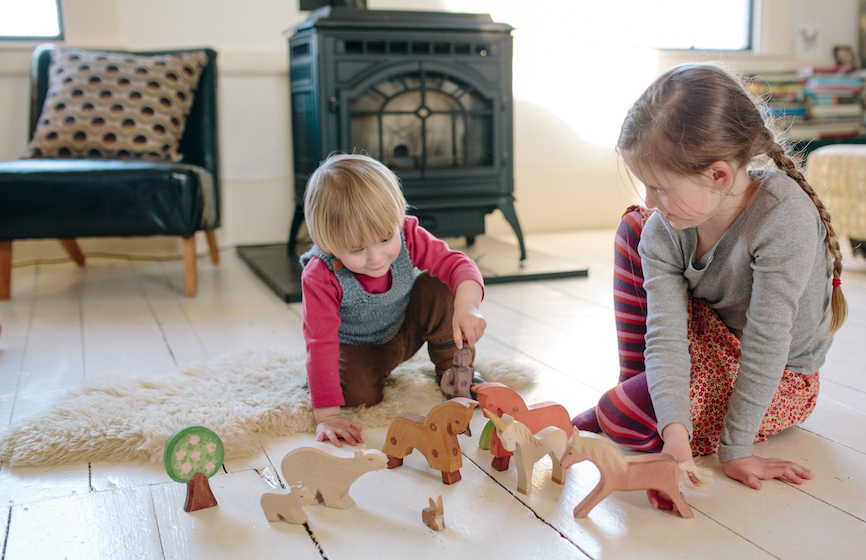

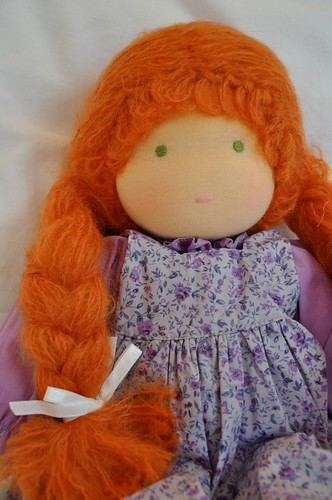
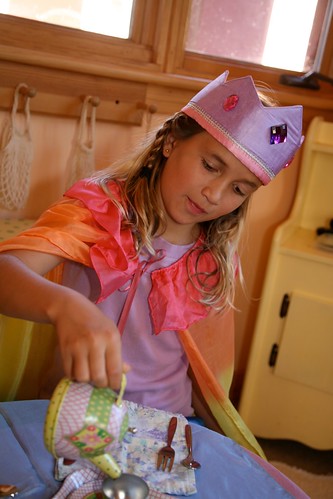
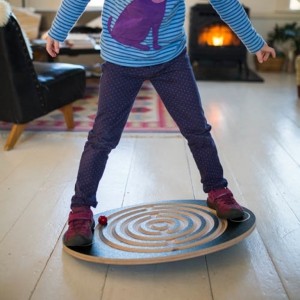
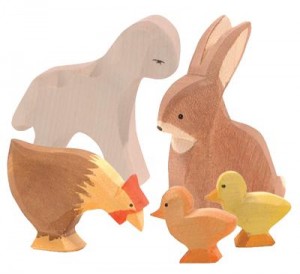

25 Comments
I really feel that ‘bringing new consciousness to selecting children’s playthings’ is a great way to put it. I try to put that amount of thought into everything I buy. Not easy when we are all so busy inn our everyday life, but it’s worth it! Even a little at a time. Thanks again for sharing your thoughts and experiences.
I love watching children use their imaginations. Too many of the toys today have all the imagination built into them… or taken out, depending on how you look at it.
~ Yaya
Yaya’s Home
It’s so true, Yaya. A child’s imagination is like a muscle that needs to be exercised.
Thank you for the wonderful insights. It has given me a much better idea of choosing “open” toys for my girls. I also loved your article on TV you posted a bit ago. Since I read it we stopped watching TV. Even though I limited my girls to PBS, I realized once we removed the TV how damaging it really was. Now there are a lot more art projects, reading and baking. What a blessing!
By the way, if my 5 year old even utters the word “TV”, my 2 year old shouts “no TV”! So thankful we removed the TV and a bit heart broken that I exposed my children to any TV in the first place. TV clearly bothered my 2 year old far more than I realized, as I am sure it does with all children, they must just become conditioned (unfortunately) to it.
Thanks again for the lovely insights. They are VERY appreciated.
In response to something I read from a Waldolf customer/fan posted in 2010 but just read it today, why would you discourage a child from watching any type of television? My profession as an attorney was greatly influenced by many of the television shows I watched as a child. Since my illness, I now a resuming a career as a doll-maker/storyteller. I have remained an artist on many levels all my life. A great portion of my inspiration came from television, right or wrong. I am saddened to hear of the disrespect directed toward the industry and the actors/actresses who work so hard to entertain and yes educate us by far beyond what they are paid.
Vickie, I don’t mean to respond for Charlotte, who posted the comment to which you are referring, but I think I can shed some light on the subject.
When it comes to television, so much depends on the age of the child. The American Academy of Pediatrics now recommends NO screen-time for children under the age of two. Why? Because numerous studies have demonstrated the detrimental effects of screen-time to a young child’s developing brain.
The first three years of life are critical to the development of the human brain. This is a period where the synapses are connecting and myelination is occurring very rapidly. (Click here for an explanation of these processes).
These processes in the brain occur when a child is having sensory experiences and is in movement — when they are discovering the world and having repeated experiences. When a child is passively viewing a screen, only certain parts of the brain are working, and other parts are shut down. The parts that are shut down will become atrophied or stunted in their development if a child isn’t having a wide variety of real-life, full sensory experiences.
While the first three years of life are the most critical, this process continues through childhood. “Myelination begins around birth and is most rapid in the first two years but continues perhaps as late as 30 years of age.”
As a Waldorf early childhood educator, I believe that the less time children spend in front of a screen (television, videos, computers, and video games) the better. But this does not mean I am anti-Hollywood. Before becoming a teacher, I worked for many years as an actress. My husband was the executive editor of Variety, the entertainment industry newspaper. My grown son (a Waldorf school grad) is now a Hollywood award-winning cinematographer. We have many friends and colleagues who work in film and television, and I have the utmost respect for artists in the industry. But after having earned a master’s degree in early childhood education and after teaching young children for more than ten years and observing them, I came to understand the great difference between an adult’s brain and a young child’s brain.
I know now that a young child should be in movement — climbing, jumping, crawling, swinging, balancing, and so forth — for optimal brain development. He needs to be observing the natural world with all of his senses. She needs to be using her hands and fingers, developing fine-motor skills, since we now know that the nerves in the fingertips connect directly to the brain.
It’s nearly impossible these days to protect a young child from screen-time. It’s everywhere! In waiting rooms, on busses, at friends’ homes, etc. But I believe that parents who try to limit it as much as possible are doing their children a great service.
Like you, I spent a great portion of my childhood watching television, which I enjoyed. I share a cultural experience with my peers (my friends my age and I can relate and enjoy a laugh when we remember “Gilligan’s Island” and “The Brady Bunch”).
But I once read a book on the subject of children and television when these ideas were new to me. The first chapter opened as follows:
“Think of the time you spent watching television as a child. Do you feel it was time well spent?”
That question hit home for me. For the first time, I wondered what my life might have been like if I had used that time differently. I might have become an accomplished pianist or dancer. I might have mastered a foreign language. I dabbled in those interests during childhood, but mastered none of them. Instead I can sing you the theme song of virtually any TV show from the 60s and 70s. So for myself, the answer would have to be no. I do not feel like it was time well spent.
For these reasons, I decided to limit the screen-time of my two children while they were growing up. Despite not using a computer or seeing many movies until high school, one son has become a computer programmer, pursuing a degree in computer science, and the other an accomplished filmmaker. Instead of consuming electronic media as children, they have gone on to become creators of media as adults.
How wonderful that you are a storyteller! My son the filmmaker has attributed the fact he has been hearing stories told since he was a young child to his ability to now tell stories through the medium of film.
I hope this sheds some light on a different viewpoint.
Warmly,
Sarah
OH! These are some of my favorite toys ever! I love natural toys like this and find it fascinating that you make & seel them. Very cool!
“Happy SITS Saturday Sharefest” What a lovely blog you’ve created! Love it! =)
what a beautiful explanation! it’s so amazing watching the imagination grow…my little boy is just about 20 months, and i could watch him for hours with his rocks that turn into trash…the “food” he feeds to his bears…even his noodles that turn into buses!
i found you on sits!
Unparalleeld accuracy, unequivocal clarity, and undeniable importance!
i love your explanation of what is good for a child to play with. i learned something… thanks.
At last, somenoe comes up with the “right” answer!
Going to put this atrilce to good use now.
Wonderful post, Sarah! Thank you so much for sharing your insights with us. I love what you’ve said about bringing consciousness to our daily activities at home. Mindful parents = mindful kids! Much love & light to you. <3
These are very cute and sustainable toys. Thanks for introducing them!
I love the little dolls who drew me to the website. I have some Waldorf friends and love the philosophy behind the toys. I will stay tuned to your store with my little grandsons in mind.
What a good way to make a living. Supporting a healthy childhood for children and using creativity and skill. Thank you.
i love waldorf toys toO!! plus the fact that it’s an eco-friendly and natural toys, these are the kind of toys we would love our children play with.
I fell in love with Waldorf ever since I first read about it over 25 years ago. My grandson is now benefitting from the nurturing, enriching Waldorf philosophy. Thank you for your website.
i remember my mom gave me a doll that looks something like that when i was a little girl! it’s a nice toys!
[…] has become obsessed with playing with sticks. This is fine. This is sweet. This is Waldorf-y. I am pleased. Unfortunately she brings them into the house and leaves them in little piles. […]
Found this while I was researching toys. I have a 6yo and a 2yo, and I want an idea of what the best open ended quality toys are from a waldorf perspective. I want a list by age. I want a relatively short list, since the main reason I’m even thinking about this is because I’m trying to organize and downsize toys, and I just think the amount we have is ridiculous. I’d love it if you blogged about this, or were able to send me a resource like this. Thank you! 🙂
I have always loved these sorts of toys without knowing that they had a name.
When I was little we did a lot of playing with rocks, berries, mud, cardboard, etc. and I see now that most kids just do not know how to play at all. They are used to toys that play for them. I have driven a lot of people crazy by asking that toys given to my daughter not be the sort that make noises when you press a button. My sister even seems to think that I am going to stunt my baby’s intellectual growth because I don’t get her all of the Baby Einstein and V-Tech toys. But I look at her little boy and see that he uses his expensive, racket-producing electronic toys more as entertainment than playthings. He knows that if he presses this button, he will hear music, so he just presses it over and over again. He doesn’t pay any attention to the skills the toy is supposed to be teaching–it’s all about the button pressing. I just don’t think that that is a healthy start. I do let my baby play with plastic toys but have tried to be picky. I am looking forward to making her some lovely handcrafted toys more like these.
Thank you so much for the article–I have been curious as to what a Waldorf toy was for a long time. So funny to find out that I’ve been in love with them all along!
I love these toys. Reading some comments makes me wonder though… the parents that are so eager to exercise the children’s imaginations… how many are going to be the same ones that reject the kids a few years down the road, when they drop out of school to pursue music, art or their own off beat path? Just some food for thought. My imagination was like the apple of my parents’ eye… until I got a period and grew breasts, then I was all of a sudden expected to be what they considered “down to earth and sensible”.
I pray to not make the same mistake with my kids.
[…] more detailed explanation of Waldorf toys can be read by Sarah Baldwin, a company owner who makes and sells […]
Such a brilliant description of the benefits and examples of waldorf toys and how anything can be seen as a toy in waldorf.